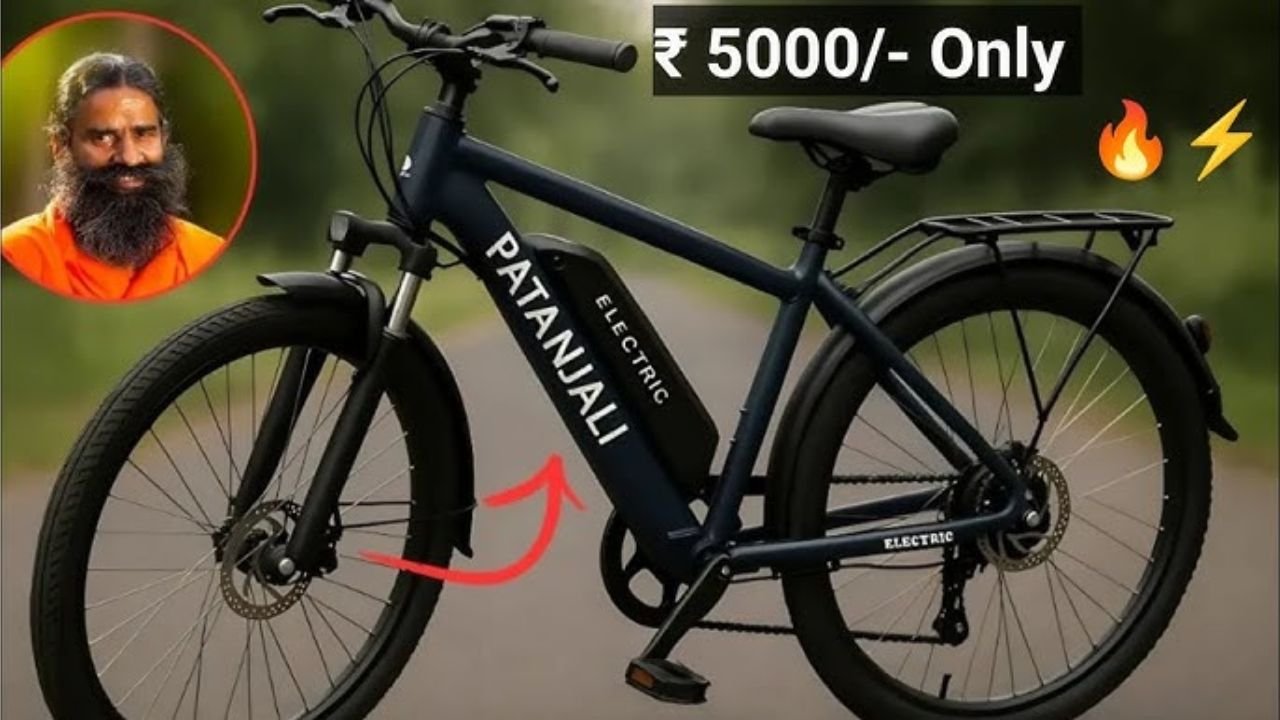Patanjali E-Cycle: India’s streets are buzzing with a new kind of electric energy. The country’s wellness giant, Patanjali, has taken an electrifying leap beyond Ayurveda and into urban mobility. With the recent unveiling of an e-cycle priced at just ₹5,000—and boasting a jaw-dropping 80 km range—Baba Ramdev is looking to redefine how India moves.
This isn’t just another cycle; it’s a bold, disruptive shift for the masses—aimed at transforming mobility from a daily challenge into a sustainable and affordable convenience.
The Launch That Made Headlines
In a packed gathering in Haridwar, Baba Ramdev unveiled Patanjali’s electric cycle with the kind of enthusiasm usually reserved for smartphone launches. “Mobility is a right, not a luxury,” he proclaimed. And true to that vision, Patanjali’s e-cycle is not just about affordability—it’s about accessibility for millions.
It’s no exaggeration to call this India’s most anticipated mobility launch of the year.
What’s Under the Hood (Or Rather, the Handlebar)
Let’s decode what makes this machine tick—and why it’s giving high-end e-cycles a serious run for their money.
Motor Magic: Power Without Papers
The e-cycle features a 250W brushless DC motor, legally capped at a 25 km/h top speed. This ensures it doesn’t require a license, registration, or insurance—perfect for urban riders and teenagers alike.
Patanjali claims the motor is engineered using advanced copper winding and high-grade neodymium magnets, achieving 15% higher efficiency compared to typical motors in the sub-₹10K segment.
Battery That Keeps You Going
Powering this e-cycle is a 36V 8.8Ah lithium-ion battery. While that might seem modest, Patanjali’s in-house battery management system makes every watt work overtime.
Thanks to adaptive energy optimization, the bike delivers an exceptional 80 km per charge. Most e-cycles at double or triple the price top out at just 40–60 km. Patanjali’s engineers have clearly rewritten the rulebook here.
Smarter Cycling with Adaptive Learning
A standout feature? The bike’s intelligent controller that adapts power delivery based on your riding habits, terrain, and battery health. It learns from your daily routes and dynamically adjusts assistance for hills, flats, or stop-start traffic.
This is AI on two wheels—simplified for the common rider.
How ₹5,000 Was Made Possible
Getting an e-cycle at this price isn’t just clever engineering—it’s strategic disruption. Here’s how Patanjali pulled it off:
No Dealers, No Markups
Patanjali cut out the middlemen entirely. With direct-to-consumer sales and its own retail stores acting as distribution centers, there’s no 30–40% dealer markup eating into your wallet.
95% Made in Bharat
The cycle is almost entirely domestically produced. From the chassis to the wiring harness, most parts come from small-scale manufacturers in Uttarakhand and UP. This local-first model not only slashes costs but also generates jobs.
Rethinking the Battery Supply Chain
Instead of importing expensive lithium packs, Patanjali partnered with Indian firms that repurpose high-quality cells from larger EV battery modules. Every battery is rigorously tested before it powers a cycle.
Built for the People, Not Profit
Patanjali is prioritizing impact over immediate returns. For the first 100,000 units, the company is working on a near-zero-profit model—viewing the project as a social mission rather than a commercial product.
Tailored for Tough Indian Roads
From the monsoons of Kerala to the lanes of Varanasi, the Patanjali e-cycle is designed to handle the chaos of Indian roads.
Lightweight Yet Sturdy
Weighing just 22 kg, it’s light enough to carry upstairs or onto public transport. The steel-alloy frame provides durability without adding unnecessary bulk.
Double Duty: Pedal or Power
Run out of charge? Just pedal on like a regular bicycle. This hybrid functionality ensures you’re never stranded—battery or no battery.
Tech-Savvy Touches
A minimalist LCD panel shows real-time speed, battery level, and power mode. And yes, there’s a USB port to juice up your phone mid-commute.
Ready for Rain and Heat
Waterproof connectors and sealed electronics make it rain-ready. Plus, the frame coating resists rust and high heat—built for every climate from Delhi’s dust to Chennai’s humidity.
Big Impact in a Small Package
This isn’t just a personal transport tool—it’s an economic and environmental game-changer.
Massive Savings for Daily Riders
At just ₹0.15/km in energy costs, it’s 95% cheaper than a petrol scooter. A full recharge costs under ₹5. Over a year, a commuter can save ₹25,000–₹30,000 in fuel and maintenance.
Cleaner Cities, One Cycle at a Time
Each rider switching from petrol to electric saves 1–2 tons of CO2 annually. Scale that to a million riders and India sees a significant reduction in urban air pollution.
Green Charging Possibilities
With low power requirements, this cycle can be solar-charged using basic rooftop panels—perfect for off-grid areas or rural India.
The Public Reacts: Demand Skyrockets
Within days of the announcement, pre-orders crossed 50,000 units—a figure that stunned even Patanjali insiders. The buzz is real, and the market is listening.
Initial production will focus on North Indian states, with pan-India availability expected by mid-2025.
What’s Next? Scaling, Service, and Support
Patanjali has set up a full-fledged manufacturing facility in Haridwar and plans to train local mechanics nationwide. A mobile service fleet is also being considered for rural areas.
Their existing store network will handle basic maintenance and parts supply—a decentralized service model for a decentralized country.
Could This Be India’s Tesla Moment?
If successful, this e-cycle may force the entire e-mobility industry to reevaluate pricing, design, and target markets. Urban India’s last-mile transport problem may have just met its match.
Manufacturers across the country are now watching closely—and probably panicking a little.
FAQs About the Patanjali E-Cycle
Q: What is the full charging time?
A: 4 to 6 hours using any standard 220V wall socket.
Q: What terrain is the cycle suitable for?
A: It’s ideal for urban and semi-urban roads, with minor inclines and rough patches.
Q: Does it come with a warranty?
A: Patanjali hasn’t disclosed full warranty terms yet, but a 1-year coverage for electricals is expected.
Q: Is it available outside India?
A: Not yet. The focus is currently on Indian states, starting with Uttar Pradesh and Uttarakhand.
Q: Can I ride it in the rain?
A: Yes. It’s equipped with water-resistant components and sealed battery housing.
Q: What’s the cost of a replacement battery?
A: Pricing hasn’t been confirmed, but expected to be below ₹1,500.
Q: Will financing options be available?
A: While not officially announced, several NBFCs are reportedly exploring micro-loans for it.
Q: Are color options offered?
A: Yes, early prototypes have been seen in black, grey, white, and electric blue.
Who Is This E-Cycle For?
This isn’t just for green enthusiasts. It’s a boon for:
- Students tired of expensive rickshaws
- Office-goers looking to cut commute costs
- Delivery workers needing low-cost mobility
- Senior citizens wanting a lighter alternative to scooters
- Rural commuters in areas lacking public transport
If your daily travel is under 20 km and you’re ready to ditch fuel bills forever—this e-cycle could be your next best investment.
Also Read
- Royal Enfield Electric Bike Is Going to Launch with 259 km Range and Heavy Battery!
- R15 V5 Red Color Comes with Amazing Engine, Rider-Friendly Features! Only Rs 7000 EMI!
- Honda Beast Bike Launches with 998 CC Engine, 6-Speed Manual, Latest Tech and Features!
- Triumph New Bike Launched with 398CC Engine & Rider-Friendly Features!
- TVS Jupiter 125 – A Perfect Blend of Style with Eco Thrust Fuel Injection technology!

Shrishti is an experienced writer and editor with a strong focus on Government Schemes, News, Technology, and Automobiles. She brings clarity and depth to complex topics, making them accessible and engaging for a wide range of readers. With a keen editorial eye and a passion for accuracy, Shrishti ensures every piece she works on is well-researched and impactful. Her ability to adapt her writing style to suit different audiences makes her a valuable voice in digital and print media, keeping readers informed and up to date with the latest developments.






